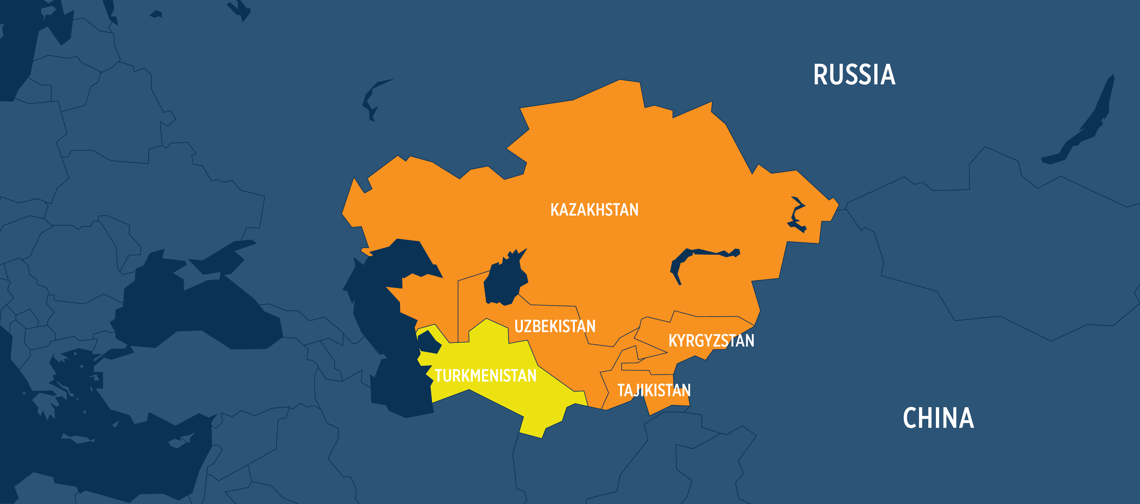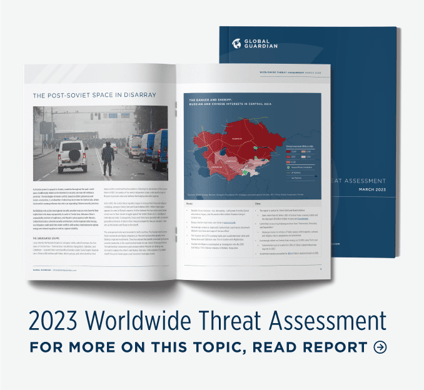While safety conditions vary across Central Asia, a well-prepared visitor can navigate these landscapes with confidence—learn more about the risks present and how to prepare.
BY Zev Faintuch, Senior Intelligence Analyst

|
JULY 23, 2023 INSIDE THIS ARTICLE, YOU'LL FIND: |
Central Asia, known for its untamed landscapes and profound history, stretches from the Caspian Sea in the west to China in the east and from Afghanistan in the south to Russia in the north. Comprising five unique countries—Kazakhstan, Turkmenistan, Uzbekistan, Tajikistan, and Kyrgyzstan—the region carries significant geopolitical weight, serving as a pivotal bridge between Europe and Asia. Its diverse geography, from desert plains to mountainous terrains, offers an array of fascinating exploration opportunities for the adventurous traveler. But this off-the-beaten-path destination does feature some safety risks, most prominent being its poor infrastructure and healthcare systems.
Background on Central Asia as a Region
Enriched by the ebb and flow of historic tides, the Central Asia region resonates with the whispers of the Silk Road and tales of great empires. Its cultural tapestry is richly interwoven with Turkic, Mongolic, Persian, and Russian influences, displaying a captivating diversity in languages and religions. Islam serves as the predominant religion, although vestiges of Buddhism and Russian Orthodoxy are still visible. The region's linguistic variety is equally impressive, housing languages from various Turkic and Persian families, Russian, and a host of local dialects.
Central Asia's Relationship to Russia and China
The shadow of history looms over Central Asia, and the region remains intricately connected to both Russia and China.
Long ruled by the Russian Empire as a singular entity called Turkestan, the five states of Central Asia – Turkmenistan, Kazakhstan, Kyrgyzstan, Tajikistan, and Uzbekistan – acquired their current political borders under Soviet leader Vladimir Lenin. These artificial lines split tribes, ethnic groups, and other identities that transcend the current political boundaries. Following the dissolution of the Soviet Union in 1991, the leaders of the newly independent states continued to look to Moscow to provide order and buttress their largely autocratic regimes.
But in 2013, the Central Asian republics began to increase their financial reliance on Beijing, owing to China’s Belt and Road Initiative (BRI). While China’s gain appears to come at Russia’s expense, friction between the two autocracies takes a back seat to their shared struggle against the United States (U.S.)-led liberal international order. Consequently, Russia and China have operated with an implicit geopolitical division of labor in their mutual backyard for the past decade: China acts as the banker and Russia as the sheriff.
"Consequently, Russia and China have operated with an implicit geopolitical division of labor in their mutual backyard for the past decade: China acts as the banker and Russia as the sheriff."
The arrangement returned dividends for both countries. The Russian and Central Asian economies are highly integrated, so Moscow has benefited greatly from Beijing’s regional investments. China has enjoyed the stability provided by Russian security leadership in the countries that border its own restive Xinjiang province. The partnership functioned in part because neither Moscow nor Beijing was inclined to replace the other’s contribution. But now, in the absence of a viable sheriff, the post-Soviet space could become increasingly violent as the informal pact unravels in the wake of Russia’s invasion of Ukraine.
Safety and Security Landscape in Central Asia
Safety conditions in Central Asia have seen notable improvements over the years, but they vary across countries and within different social contexts. For instance, while Kazakhstan and Kyrgyzstan have focused on urban safety initiatives reducing crime rates in cities like Almaty and Bishkek, issues persist concerning the societal treatment of women and religious minorities. The region also grapples with challenges like human trafficking and drug smuggling, especially in areas bordering Afghanistan.

Is Kazakhstan Safe? Medium Risk
As the most economically advanced nation in Central Asia, Kazakhstan is generally safe for travelers. However, instances of petty crime like pickpocketing and burglary are not uncommon in urban areas, especially in nightlife districts of major cities like Almaty and Nur-Sultan. Travelers are thus advised to maintain a low profile, avoiding public display of valuables. Authorities have also made concerted efforts to enhance road safety, though it remains a concern.
Is Turkmenistan Safe? Moderate Risk
Turkmenistan, an autocratic regime, is stable but imposes highly restrictive societal norms. Travelers should be aware of strict codes of conduct, heavy internet censorship, and frequent monitoring of public and private communications. Nonetheless, crimes against tourists are relatively rare, indicating that personal safety, though contingent on strict obedience to laws, is generally ensured. Protests and demonstrations are rare in Turkmenistan, as all forms of civil disobedience and dissent are strictly forbidden and suppressed harshly. While some sporadic protests over food shortages may occur in urban areas, including Lebap and Mary regions, they usually fail to become widespread.
Is Kyrgyzstan Safe? Medium Risk
Kyrgyzstan, a mountainous country known for its nomadic culture and stunning landscapes, has a relatively good safety record. However, it has experienced periods of political instability that have led to occasional protests and civil unrest. Examples include the upheavals in 2005 and 2010 when changes in government leadership sparked nationwide protests. Thus, travelers should stay updated on current affairs and avoid large gatherings or demonstrations. Crime rates in Kyrgyzstan have increased in recent years, particularly in rural areas. Violent muggings after dusk are common and may result in severe injury. Pickpocketing and car theft are also common. Foreign nationals have been targeted in assault, robbery, and carjackings.
Is Tajikistan Safe? Medium Risk
Tajikistan is generally considered mostly safe for travel, despite its troubled past marked by a civil war in the 1990s and the latent threat from Islamist militants and extremists. The threat is particularly concentrated in the Khatlon and Sughd border regions, where groups such as the Islamic Renaissance Party of Tajikistan (IRPT), Jihad Union (IJU), Islamic State (IS)-linked Islamic Movement of Uzbekistan (IMU), and the Eastern Turkistan Islamic Movement (ETIM) are active. Tajikistan is situated in an active seismic zone, making it susceptible to earthquakes. For instance, the 2015 earthquake in Murghob impacted many travelers and local residents alike, highlighting the importance of being prepared for natural disasters.
Is Uzbekistan Safe? Medium Risk
Uzbekistan, famed for the Silk Road cities of Samarkand, Bukhara, and Khiva, has made great strides in improving safety, especially for tourists. Despite this, visitors are advised to stay vigilant, particularly in crowded bazaars or while using public transportation, where pickpocketing is occasionally reported. Uzbekistan's government has shown a dedication to tourism safety, exemplified by initiatives like the "Safe Tourism" certification for businesses adhering to high safety and quality standards.
Future Risks in the Region
Central Asia faces potential risks and challenges that could impact its safety and security landscape. Geopolitical factors, such as the region's proximity to volatile areas like Afghanistan and its complex relationships with a Russia in decline and China, contribute to this uncertainty. Emerging threats, including the rise of extremist ideologies, potential for border disputes, and the impact of climate change on already scarce water resources—exemplified by the rapidly shrinking Aral Sea—pose significant future challenges.
In the medium-to-long term, with the new geopolitical reality beginning to set in, we see an increased probability of major bouts of civil unrest on the horizon. In the past, the autocrats of Central Asia have relied upon Russia to put down significant protests, even as recently as 2021 when Moscow intervened under the auspices of the Collective Security Treaty Organization (CSTO) or mediate between warring countries. But Russia’s resources and attention are directed elsewhere and it is difficult to imagine Russia having the capacity to reclaim its previous position as the “sheriff”—the security provider and guarantor—of the region. China—owing to its unpopularity—cannot simply step in to fill this void. With a number of aging dictators, resource scarcity, transnational inter-ethnic tensions, and unimpressive economic growth to uplift the prospects for the regions’ young populations, the structural factors that are conducive to political unrest are already in place.
Meanwhile, the reemergence of the Nagorno Karabakh conflict in the nearby Caucuses is the canary in the coal mine for what might transpire should interstate conflict erupt. The presence of Russian peacekeepers was not enough to prevent Azerbaijan from exploiting Russia’s abdication of its regional role. Nor was Russia able to use any leverage to promote peace. The Ferghana Valley, which straddles Uzbekistan, Tajikistan, and Kyrgyzstan is home to the regions best pastoral real estate and is a significant source of fresh water. There have been numerous small skirmishes between Kyrgyzstan and Tajikistan that tend to arise when one of the leaders needs to shore up domestic legitimacy. With innumerable exogenous triggers, the despots of Uzbekistan, Tajikistan, and Kyrgyzstan could use provoking a conflict in the Ferghana Valley to distract from domestic problems in the future.
The Importance of Travel Insurance and Health Considerations
Travel insurance is a critical component of any trip to Central Asia, providing protection against unforeseen circumstances, from flight cancellations to medical emergencies. Prior to traveling, it's also important to consult healthcare professionals regarding necessary vaccinations, such as those for typhoid or hepatitis A. Access to healthcare facilities varies across the region, but it generally falls far below Western standards. Urban areas typically offer better services, for instance Almaty in Kazakhstan houses a few well-equipped private clinics, while more remote areas feature very little medical infrastructure.
Before traveling to Central Asian states, travelers should strongly consider enrolling in a medical evacuation service to help ensure they receive the care they need and deserve.
Central Asia, with its remarkable history and diverse cultures, offers a treasure trove of experiences for the intrepid traveler. While safety conditions vary across the region, a well-prepared visitor can navigate these landscapes with confidence. Remember to stay vigilant, respect local customs and laws, and keep abreast of current affairs. Travelers should also avoid traveling in the winter where extreme temperatures put a strain on energy grids and can cause travel delays and even make land travel quite dangerous. With underdeveloped health systems across the region, having a medical evacuation service lined up will help provide you with peace of mind, helping to mitigate the regions’ most acute travel risk. With the right preparation, your journey through Central Asia will not only be safe, but also deeply enriching.
StandinG By to Support
The Global Guardian team is standing by to support your security and medical requirements when traveling to and staying in Central Asia, including:
- Duty of Care Membership
- Custom Intelligence
- Executive Protection and Transportation
- Air Ambulance Medical Evacuation
To learn more about our pre-trip and crisis response services, complete the form below or call us at + 1 (703) 566-9463.




